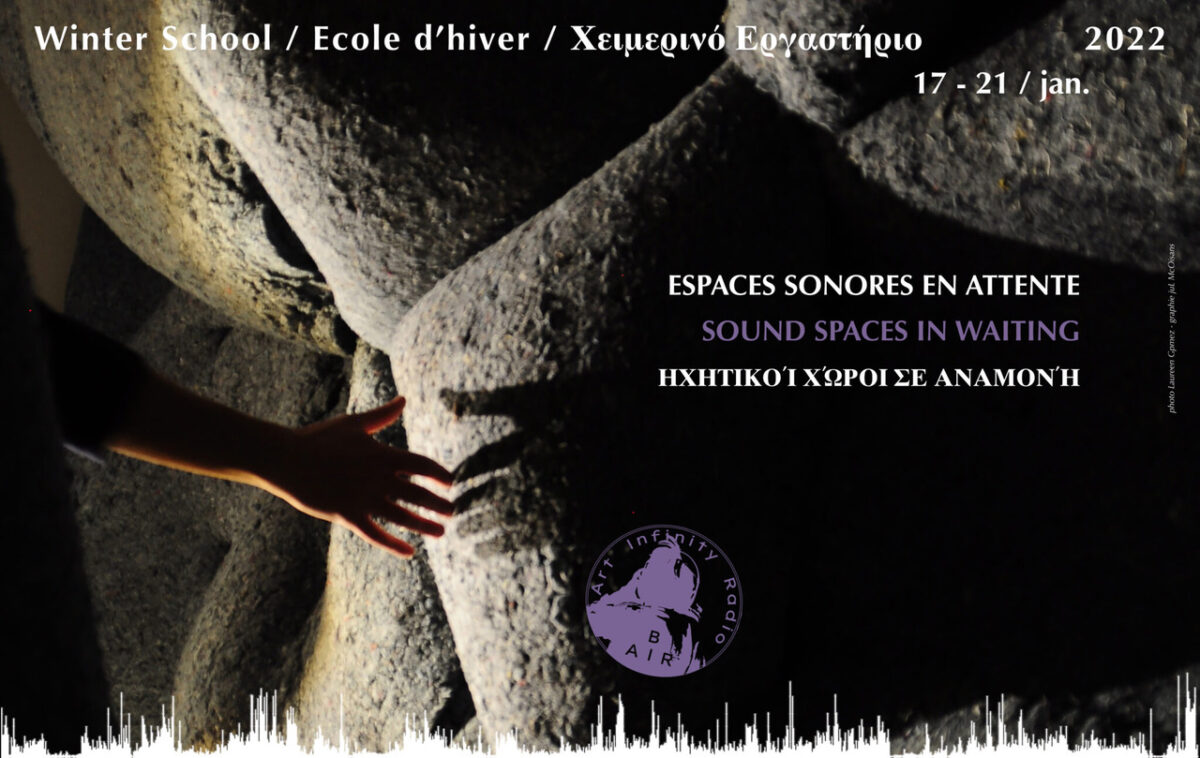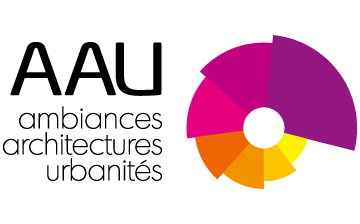For the second consecutive year, the WinterSchool organised by the CRESSON team of the AAU laboratory hosted the B-AIR project and continue the reflection carried out in 2021 around the general theme of listening vulnerabilities.
« Listening to the world » can be seen today as a posture of scaling facing the usual frames of reference and allows us to pay more attention to vulnerabilities: how does the world sound to our ears? How does it sound when we are children? How does it sound when our bodies suffer and age? How does it sound when our senses or our beings are « different »?
To answer these questions, in 2021 we explored the theme of the vulnerability of listening and showed that it can be broken down into three interdependent dimensions: environmental, social and spatial vulnerabilities.
This year, the 2022 edition proposes to the participants to think more precisely about the cultural and spatial dimensions of the perception of ambiences by working on « sound spaces in waiting »: architects, urban planners, artists, designers, but also inhabitants, we conceive and occupy the public spaces of our cities and the landscaped space is often the place of various sound practices: words, musical listening, sports practices, walking, stay, meetings, etc. How can we design public space and its furniture to be less vulnerable? How can a public bench become a waiting sound space, ready to be activated by an individual (a hearing impaired person, a group, a child, etc.)? How can these urban objects be designed and constructed to provide multiple, sensitive and multicultural listening experiences? What kind of « sound spaces in waiting » can be designed and built to give or bring attention to the vulnerabilities and pluralities of uses and spaces?
* * *
The CRESSON WinterSchool took place in parallel at the Ecole Nationale d’Architecture de Grenoble, and and at the Department of Architecture of the Polytechnic school of the University of Thessaly in Volos (Greece).
From Monday 17 to friday 21 January 2022. The mornings were dedicated to theoretical presentations (in English) and the afternoons (in French and Greek depending on the site) were dedicated to the design and construction of a series of body-scale prototypes to think and experiment with these sound spaces in waiting.
* * *
General Chair :
Théo Marchal & Sébastien Depertat (Grenoble)
Nicolas Rémy, Evangelia Paxinou and Dimitris Psychogios (Volos)
with
Françoise Acquier, Giorgia Amico, David Argoud, Grégoire Chelkoff, Julien Clauss, Sylvia Cucchi, Giuseppe Gavazza, Laureen Gomez, Sylvie Laroche, Annie Luciani, Damien Masson, juL McOisans, Lejla Odobašić Novo, Dana Papachristou, Cédric Pichat, Georges Samantas, Jean Paul Thibaud, Nicolas Tixier, TwixTlab, ( … )
* * *

This publication [communication] reflects the views only of the author, and the Commission cannot be held responsible for any use which may be made of the information contained therein.
|
|

Programm & recordings
Monday
Arts to Science :
- Sound spaces in waiting
(Nicolas REMY/ Théo MARCHAL)
- Urban transports as sonic infrastructures of feeling: hearing, mapping, understanding
(Damien MASSON)The daily experiences of urban transports bring into play tactile, body-to-body, breathing, sweating, sound, etc. More than visual and embodied, these pathic experiences invite us to propose renewed geographies of urban mobilities. This intervention proposes a theoretical and methodological reflection on an ordinary aesthetics of transport infrastructures which are considered as infrastructures of feeling. In doing so, we aim to comprehend their active role in the formation of sensitive experiences and affective atmospheres of ordinary mobilities.To do so, this paper will use two research projects which aim at understanding collective emotions and embodied power relationship in Paris’ train and metro infrastructures. Firstly, the mobile and sensory methods that have been used to grasp the emotional, embodied, ethereal etc. at play will be presented. Secondly, we’ll develop a mapping attempt of some of the researched situations, which proposes to substitute time for space in order to highlight the importance of the temporal dimension in the expression of the lived situations. Lastly, we will propose an open reflection on the possibilities visual translation of more-than-representational phenomena its stakes and limitations.
- Micro-radio : formes et sociabilités des ondes radio
(Julien CLAUSS)Plus vieux des nouveaux média, la radio a introduit dans la société un usage infus des champs électromagnétiques. De la TSF au DAB en passant par la FM, la nature invisible des ondes radio a conféré à ce média une aura singulière. Des installations explorant la physicalité des ondes radio aux dispositifs de micro radio participatifs, Julien Clauss présentera un panorama de projets artistiques qui convoquent plastiquement la radio.
- Cartophonies
(Sylvie LAROCHE)In parallel to quantitative acoustic maps, a diversity of cartographic representations of the sound environment is developing. Among these, I will present the second version of the « cartophonies » tool (interface developed by the Cresson laboratory). From these examples, which present a better sharing of sound ambiences in time and space, I will explore the remarkable sound dimensions of a place.
- Virtual Echo, Propagation and Absorbsion Frontiers’s fluidity and Dynamic Heterotopia
(Annie LUCIANI / Giuseppe GAVAZZA)In this presentation, we examine the conjunction between (1) the mythologic concepts of auditory echo and reflection, (2) their extension to visible phenomenon, (3) a new digital technology and a new interactive art. We introduce a new concept, called “interactive simulated matter” allowing to render wide variety of echoes, reflections or more or less permanent absorbing effects in response of actions.Such simulated phenomena enlarge the realistic ones – acoustical echo or optical mirroring – by creating intermediate situations of propagation, echoes and permanent or ephemeral absorbsions and engraving. The concept of interactive and dynamic simulated matter illustrates the concept of heterotopia with an intimate intertwining of space and time. Further, it explores, in visual arts, the notion of the frontiers, from clearly-cut limit to total evanescence, not only in terms of space but also in terms of time.Fundamentally speaking, such questions address the question of the fluidity of the frontiers, not only in terms of space but also in terms of time. It is why we can speak here on “dynamic heterotopia” as a temporal point of view of the concept of heterotopia developed by the French philosopher Michel Foucault in social spaces.
- The Soundscape of War
(Lejla Odobasic Novo)The sound of an urban space is both performed by people as well as shaped by the natural and man-made aspects of the urban environment. Architectural planning seeks to create an acoustic equilibrium, taking into account the city’s natural geography. This is also the case for Sarajevo, a city that sits in a valley, with a carefully constructed acoustical equilibrium in its conception. During the four-year siege this acoustical equilibrium was unquestionably upturned. Through this research we examine the soundscape of war as experiences by fifteen witnesses that survived the siege of Sarajevo. We look at the acoustic implications on urban space and collective memory both during and after the war.
Tuesday
Sound, space and fieldwork :
- Materiality and Audibility – working with Deaf adolescents and sound
(Dana PAPACHRISTOU/ Yorgos SAMANTAS)In the framework of B-Air, TWIXTlab has been working with artists and with Deaf and hard-of-hearing children and their educators in their school setting, exploring alternative experiences with sound through artistic practice. In the presentation, we will reflect on our experience from the field, our methodology of approaching the classroom, and our future actions. Further, we will explore materiality as a valuable aid for alternative ways of listening and engaging the children with the sonic universe, as well as the spatial aspects of the educational/artistic process.
- Listening Pieces/Rooms
(Grégoire CHELKOFF)For several years we have experimented spatial devices at the scale of the moving body in different situations to create sound pieces / rooms. Designed through spatial notions as articulations, limits and inclusion, these devices can respond to certain issues in daily life, habitat or public space.The objective is to create spaces and situations through thethe through the sound experience sought, often on a small scale according to weak or not very important wall proximities and according to simple gestures of use. Once completed, the « listening pieces / rooms » will also solicit the other senses associated with the spatial experience: movement, tactility, luminosity, scents in order to question the sensory interactions and ambient qualities evoked or perceived in the installations produced. A brief overview of these experiences will show some exemples, the categories and the method used.
- Losonnante: a bone conduction listening device
(Sebastien DEPERTAT/ ThomasBONNENFANT)
Losonnante is a bone conduction sound device that attempts to renew the approach to sound and listening in their relationship to living environments. Based on a micro digital audio system, the listening requires to rest the elbows on the device while resting the hands on ears. Thus, it offers an immersive experience that work on questions such as form, aesthetic, listening position, attention and sound content. This presentation will be a general introduction to this device and will question the way it could open up other ways of listening and being attentive to our living environment. In particular, we will speak about the listening of Knud Viktor’s oeuvre through this device. Knud Viktor was a Danish artist, a « sound painter » who spent a large part of his life composing from the micro-sounds from his environment.
Friday
B-AIR Lectures :
- A journey through soundscapes heard by special ears: Soundwalk, soundscapes and composition
(Sylvia CUCCHI / Giorgia AMICO)People with special needs actively explore and make sense of their environment in a personal way. We need an approach to music and sound education that appeals to people with special needs to support making sense of everyday life. We present and discuss a individualized music education project with a woman with special needs experienced through soundwalks with the creation of a personal soundscape. The goal of the experience is to explore a mode of listening in which educators and special learners live and play out their own cultural experiences through sounds that coexist and interact. Unconventional notation in the setting represents a potential space where listening becomes shared creation and composition, starting form individual coding and decoding to produce and document new or imaginative collective responses.Music education is often based on motor synchronization activities with an emphasis on sharing rhythm and time, but researchers have often found differences in individuals with disabilities ( e.g Autism Spectrum Disorders -ASD and Attention Deficit Hyperactivity Disorder – ADHD) in the body-environment relationship through the sense of time, with the result that these individuals may experience loneliness in the music lesson.Creative activities based on soundscape listening could facilitate the development of sound-based relationships, resulting in collective representation and potentially reducing any negative experiences in sharing musical activities.Interactive Soundwalks and landscape perception through shared listening, by emphasizing the close relationship between music, culture, and identity, promote shared decision making, participatory bonding, and interaction with the environment and offer a fertile context for redefining the role of music education in the curriculum.
- « B-Air online radio Platform »
(Gregor PIRS, Jan JONA JAVORSKEK)
|


